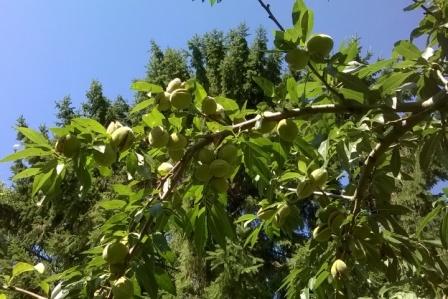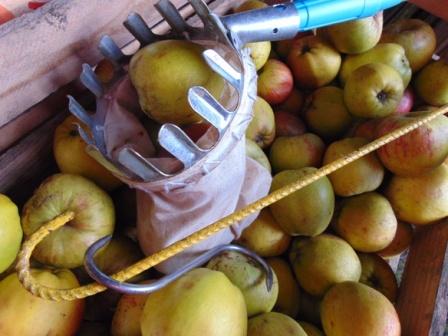Fruit that you want to keep as long as possible, you should not pick too ripe. The right time to pick the fruit for storage is when the ripest ones begin to fall.
Do it before the first autumn storm comes, otherwise he’ll pick your fruit.
When is a fruit ripe (to pick)
In most, but not all fruits the color gives an indication. Which changes from green over yellow-orange to red. (Blackberries and currants, pepper, tomato, cherry ...) Some plums and many pear varieties ripen green (to yellow).
There are obviously -sometimes large- differences between (early and late) species and varieties.
Apples and pears are ripe when they have a delicious (sweeter) flavors, feel softer, the seeds color dark (instead of white or pale) and the stalk easily breaks loose from the branch as you move the fruit around and forth; wasps and birds come eating them, the first and ripest fruits start falling. If the apple pips are brown, the apples are ripe, ready to pick.
Fruits that you want to store longer can better be picked earlier, before they are (too) ripe. They will rot less quickly. If they are harder and more acidic they keep better.
Pick them with stalk, which better preserves (the fruit itself will be hurt less, no entry for bacteria ...).
Many fruits will still ripen after picking (redder colors, become softer and sweeter).
Immature harvested (or dropped by storm) fruits are still suitable for jams and hot preparations.
 Pick carefully, do not squeeze the fruit, do not put too much fruit at each other, put some towels on the bottom of your basket. So treat the fruit like fragile eggs and don’t crush them!
Pick carefully, do not squeeze the fruit, do not put too much fruit at each other, put some towels on the bottom of your basket. So treat the fruit like fragile eggs and don’t crush them!
Picking is done by including the whole fruit (loosely) with your hand and nod upward (or sideways) till the stem breaks of the twig.
With pears you often have to hold the stem too because it breaks(too) easily.
Make sure that the stems are left. This prevents injury, dehydration and rot. Especially pears are sensitive.
Two fruits (apples) that hang stick together your best picks simultaneously in one time with one hand. If you take just one the other often will off fall.
For branches that are heavily loaded you first pick the fruits closer to the trunk. Those on the end keep the branch bent, so you easily can reach it. If you pick those first, then the branch goes back up and sometimes out of reach.
Pick preferably middle of the day, in dry weather. Be careful. Soft and ripe fruit is highly sought by wasps. The bastards even crawl (from below) in the fruit. And it's hard picking with swollen hands...

With a rake you come a long way too.
In the tall standard tree time we were still working with wooden ladders. A ladder of 48 sports (distance beteen rungs approx. 28 cm) weighs 55 kg. Straightening them was rather a job for two men. And the third stood with his feet at the points, so that it is not sliding over the ground. (Or you could blow pens or a stake in the ground.) To move them you keep them as straight as possible. Left hand under the third rung, right against the stile (uprights) as high as possible. A little out of balance makes is heavy, and even untenable.
Cherry picking is e.g. possible at 7 to 10 kg / h.
Very convenient is an apple picker. Curve a strip of metal of about 8 cm wide and 50 cm long. The ends are attached to each other to form a ring. At the top there are protruding bulges like thumbs (wide) with about an inch (2 x 5 cm) between them. They are bent slightly inward. Hang a cloth bag on the bottom with room for about 5 apples. It still requires a stem holder. (Sometimes they can be found in a Do-it - yourself shop.) I use a handle of a window cleaner that can be extended up to 4 meters. So I can pick about 6 meters high (or far) from the ground floor. Even at the neighbors. And it is also easy to transport with a bike (or car) (as opposed to a ladder). You can use it also on a ladder. The thickest and tastiest fruits are often unattainable high or far. But with the apple picker it will succeed. You can also use it to pluck the top with all ripe fruit without hurting the rest by stabbing a ladder between the branches. Really worth a small investment.
You can make one with a 2 liter PET bottle, cut the bottom off and press a long broomstick in the neck. A second stem with close fitting tubes at the ends can serve as intermediate and lengthening piece. (If necessary, secure it with a pen.) We called it a pick stick.
You can also replace the collection bag with a trunk (eg from old sleeves or trouser legs) so that the fruits can slide down.
For cherries and small plums you can also connect drain pipes to each other. Saw and fold a picking claw at the top, at the bottom you can hang a bag.
Branches that are really unreachable you just clip or break off immediately while picking. It makes no sense to grow year after year the finest fruits on inaccessible branches. The energy they take, the tree can use elsewhere for your fruit.
Choose proportional developed fruits without damage storage. Very large fruits are usually shorter preservable. Still unripe fruits aren’t and won’t come to taste anymore.
In the Middle Ages the apple was recommended as medicine. (An apple a day keeps the doctor away.) You should not eat too much, because the apples then were very acidic when compared to our present species.
Even the wild apple was important as a raw material for verjuice (see <Making vinegar >).
Also tubers, roots and leafy vegetables are best harvest without bruising, they’ll fade and they spoil less quickly. Harvesting should not always wait until all species are ’ripe’. Young carrots and peas are very tasty. Old radishes not at all, they taste rotten and tough.
Grass is edible, but not tasty (hearsay) and not digestible, even if it is cooked. It has sharp mini hairs that can damage the mouth and stomach.
Grazers are ruminants with multiple stomachs, our digestive system is not set up for this.
Collecting is building stockpile to overcome difficult times. Ever, it was mostly about fuel (wood) and food (fruits, mushrooms, carrots, etc.). So, necessary and useful. Primarily the responsibility of the women, who now have changed their baskets and bags for labeled handbags. Collecting is a second nature for a lot of people. Stamps, tools, shoes, music, information... You can even use it as an excuse to do (also nonsensical) bargains.
